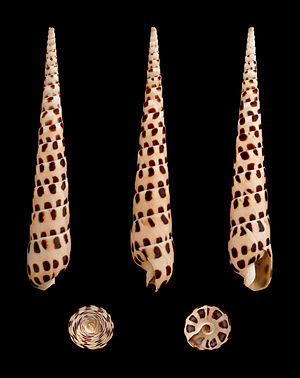Awl snail
| Awl snail | ||||||||||||
|---|---|---|---|---|---|---|---|---|---|---|---|---|

Housing of Terebra subulata |
||||||||||||
| Systematics | ||||||||||||
|
||||||||||||
| Scientific name | ||||||||||||
| Terebra subulata | ||||||||||||
| ( Linnaeus , 1767) |
The Pfriemenschnecke ( Terebra subulata ) is a snail from the family of terebridae that the Indo-Pacific is widespread and polychaete (Polychaeta) eats.
features
Terebra subulata has a long and slender, pointed, tower-shaped snail shell with about 25 well-rounded circumferences, which in adult snails reaches 9 to 17 cm in length. With a length of about 11.5 cm, the housing is 1.6 cm wide and the housing mouth is about 1.6 cm long. The outer lip of the very small case mouth is thin, the spindle is folded, the fasciole is flat, and the anterior canal is cut and curved. The case is sculptured with fine, axially running threads and spiraling, irregular, weak grooves, whereby the area under the seam is raised to a spiral band. The surface of the bowl is cream-colored with a characteristic pattern of two rows on the circumference of the thread and three rows of dark brown, square spots on the circumference of the body.
distribution and habitat
Terebra subulata is distributed in the Indo-Pacific from the coast of East Africa and Madagascar to eastern Polynesia , north to Japan and Hawaii and south to Australia ( Queensland ). In India it is quite common on the coasts of Lakshadweep , Tamil Nadu ( Chennai ), Gulf of Mannar ( Krusadai Islands ) and the Andaman Islands . It lives in the intertidal zone and a little below it to a depth of about 10 m on sandy surfaces.
Development cycle
Like all screw snails, Terebra subulata is sexually separate and the male mates with the female with his penis . The Veliger larvae swim free before they sink and metamorphose into crawling snails .
nutrition
Terebra subulata feeds on sand-dwelling Vielborstern (Polychaeta) and acorn worms , they with their hollow needle-like Radulazähnen stings and paralyzes by lethal injection. The poison acts on annelids and roundworms, but not on vertebrates. On the coast of Guam was Spionide Laonice cirrata detected as prey.
literature
- R. Venkitesan, AK Mukherjee (2012): Contribution to the knowledge on Indian marine molluscs: Family Terebridae. Records of the Zoological Survey of India 111 (3), pp. 49-77, here p. 69.
- George Washington Tryon: Manual of Conchology, structural and systematic, with illustrations of the species , vol. VII; Academy of Natural Sciences, Philadelphia 1885. T [erebra] subulata Linn., P. 10.
Web links
- Underwater Kwajalein: Terebra subulata (Linnaeus, 1767)
- Fischhaus Zepkow: Family Terebridae - screw snails
- Terebridae. From: JM Poutiers: Gastropods . In: Kent E. Carpenter, Volker H. Niem (Eds.): FAO Species identification guide for fishery purposes. The living marine resources of the Western Central Pacific. Volume 1: Seaweeds, corals, bivalves and gastropods. Food and Agriculture Organization of the United Nations, Rome, 1998. pp. 629-636.
Individual evidence
- ↑ Julita Imperial, Maren Watkins, Ping Chen, David Hillyard, Lourdes J. Cruz, Baldomero Olivera (2003): The augertoxins: Biochemical characterization of venom components from the toxoglossate gastropod Terebra subulata. Toxicon 42 (4), pp. 391-398.
- ↑ John D. Taylor (1986): Diets of sand-living predatory gastropods at Piti Bay, Guam. Asian Marine Biology 3, pp. 47-58.